rtca do-367 标准
常见电磁兼容和电性能检测检测项目模板
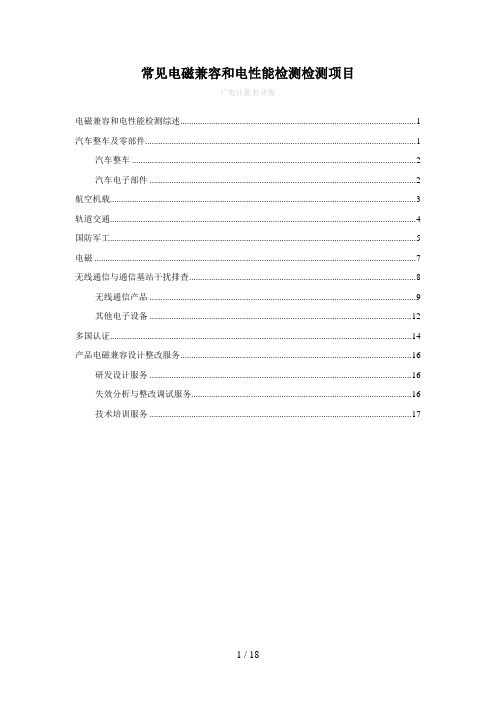
常见电磁兼容和电性能检测检测项目广电计量杜亚俊电磁兼容和电性能检测综述 (1)汽车整车及零部件 (1)汽车整车 (2)汽车电子部件 (2)航空机载 (3)轨道交通 (4)国防军工 (5)电磁 (7)无线通信与通信基站干扰排查 (8)无线通信产品 (9)其他电子设备 (12)多国认证 (14)产品电磁兼容设计整改服务 (16)研发设计服务 (16)失效分析与整改调试服务 (16)技术培训服务 (17)电磁兼容和电性能检测综述广电计量在广州、武汉、北京、无锡检测基地建有电磁兼容实验室,并与各地电磁兼容检测机构和实验室达成战略合作,为各大企业解决电磁兼容与电磁辐射影响的各类安全问题。
下设技术研究院所属的电磁兼容研究所为客户提供电磁兼容设计、标准建立以及科研项目验收等服务。
服务类型:●汽车整车及零部件●航空机载●轨道交通●电力设备●医疗用电子设备●国防军工●电磁●无线通信及其他电子设备●船载电子设备汽车整车及零部件广电计量汽车电磁兼容检测能力获日产、神龙、江淮、吉利、宇通等整车厂认可,完全满足民品汽车整车及零部件电磁兼容检测领域有关国际、国家和行业标准,以及各车厂标准,汽车电子电磁兼容检测技术能力处于行业领先水平。
审核认可:日产认可实验室神龙认可实验室江铃认可实验室广汽认可实验室一汽轿车认可实验室E8/E9/E11认可实验室北汽认可实验室众泰认可实验室……汽车整车所有乘用车、商用车、货车及挂车■检测项目■检测标准整车对外电磁辐射 GB14023/CISPR 12整车对内辐射 GB18655/CISPR 25整车辐射抗干扰 ISO 11451-2整车大电流(BCI) ISO 11451-4整车静电放电(ESD) GB/T 19951/ISO 10605汽车电子部件汽车电子控制装置:包括动力总成控制、底盘和车身电子控制、舒适和防盗系统等。
车载汽车电子装置:包括汽车信息系统(车载电脑)、车灯、汽车胎压监测系统、导航系统、汽车视听娱乐系统、车载通信系统、车载网络、倒车影像后视系统、车载领航员后视摄像头等。
飞机雷电防护试验的有关标准

广电计量—环境可靠性与电磁兼容试验中心/1.FAR-25和CCAR-25FAR-25《美国联邦航空条例第25部:运输类飞机适航条例》是由美国FAA(联邦航空管理局)颁布的,其中“25.581 闪电防护”、“25.954 燃油系统的闪电防护”、“25.1316 系统闪电防护”与雷电防护有关,分别对结构部分、燃油系统及机载电子设备的雷电防护能力作了要求,但没有规定防护能力的验证方法。
CCAR-25是由中国民航总局颁布的运输类飞机适航条例,与FAR-25内容基本相同。
适航条例对飞机的雷电防护能力提出了要求,飞机获取适航证前,需验证这些能力,当不能满足任一条款对飞机雷电防护的安全性要求时,适航审查当局将拒发适航证,飞机也不得进入航线。
飞机雷电防护适航审查的符合性方法通常有分析计算法、类比法和地面模拟雷电试验法。
分析计算方法主要用于飞机某些能得出准确解得局部结构和部件的计算。
类比法主要是将外形、结构和用途都基本相同的飞机或结构与部件,与已通过适航审查的飞机或结构与部件进行比对,确实相同则可认为满足要求。
地面模拟雷电试验法,主要用于新机型的研制、设计和老机型的改进或改型设计。
由于飞机外形的不规则性及机械结构与电气电子系统的多样性与复杂性,电场与磁场的精确解非常困难,故上述方法中地面模拟雷电试验方法最有效。
目前国内进行地面模拟雷电试验可参考的标准主要有两个RTCA/DO-160和GJB3567A。
2.RTCA/DO-160RTCA/DO-160《机载设备环境条件与测试规程》是由RTCA(航空无线电技术委员会)下属的SC135特别委员会起草制定的。
DO-160的适用对象包括了所有的航空飞行器,从轻型到重型,从小型到大型,它提供了一整套实验室测试方法以判定被测对象在模拟的环境条件下是否满足规定的性能指标要求。
目前,RTCA/DO-160已更新至F版本(2007年12月发布)。
RTCA/DO-160中的第22节为“雷电感应瞬变敏感度”,第23节为“雷电直接效应”。
震动测试标准
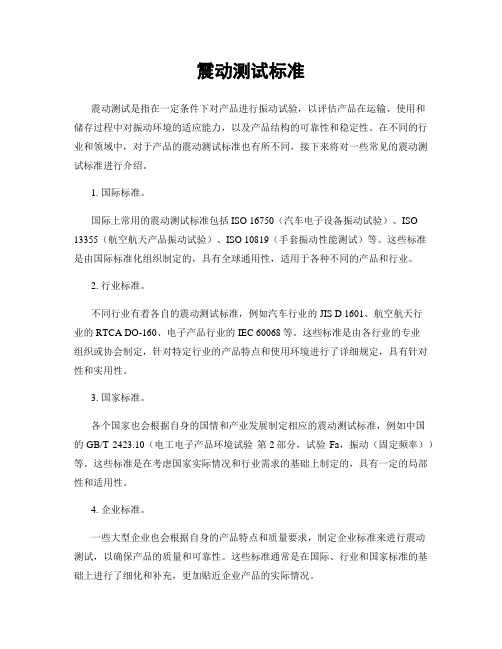
震动测试标准震动测试是指在一定条件下对产品进行振动试验,以评估产品在运输、使用和储存过程中对振动环境的适应能力,以及产品结构的可靠性和稳定性。
在不同的行业和领域中,对于产品的震动测试标准也有所不同,接下来将对一些常见的震动测试标准进行介绍。
1. 国际标准。
国际上常用的震动测试标准包括ISO 16750(汽车电子设备振动试验)、ISO 13355(航空航天产品振动试验)、ISO 10819(手套振动性能测试)等。
这些标准是由国际标准化组织制定的,具有全球通用性,适用于各种不同的产品和行业。
2. 行业标准。
不同行业有着各自的震动测试标准,例如汽车行业的JIS D 1601、航空航天行业的RTCA DO-160、电子产品行业的IEC 60068等。
这些标准是由各行业的专业组织或协会制定,针对特定行业的产品特点和使用环境进行了详细规定,具有针对性和实用性。
3. 国家标准。
各个国家也会根据自身的国情和产业发展制定相应的震动测试标准,例如中国的GB/T 2423.10(电工电子产品环境试验第2部分,试验Fa,振动(固定频率))等。
这些标准是在考虑国家实际情况和行业需求的基础上制定的,具有一定的局部性和适用性。
4. 企业标准。
一些大型企业也会根据自身的产品特点和质量要求,制定企业标准来进行震动测试,以确保产品的质量和可靠性。
这些标准通常是在国际、行业和国家标准的基础上进行了细化和补充,更加贴近企业产品的实际情况。
总结。
不同的震动测试标准适用于不同的产品和行业,选择合适的标准进行测试对于评估产品的可靠性和稳定性至关重要。
在进行震动测试时,需要根据产品的特点和使用环境选择相应的标准,并严格按照标准要求进行测试,以确保产品在实际使用中能够经受住各种挑战和考验。
同时,不断完善和更新震动测试标准,也是提高产品质量和竞争力的重要手段。
关于RTCA DO160G机载设备环境试验条件解读

RTCA/DO-160G环境试验条件解读4.0温度、高度试验4.5.1 地面耐受低温试验和低温短时工作试验在环境大气压力下,设备不工作,将设备温度稳定于表4-1 规定的地面耐受低温至少3 小时。
设备不工作,使其按表4-1 中提供的短时工作低温存放至少30 分钟。
保持试验箱内的温度继续为表4-1 提供的相应的短时工作低温,使设备至少工作30 分钟。
4.5.2 低温工作试验在环境大气压力下,设备工作,将试验箱的温度设置为按照表4-1 查出的相应的工作低温。
当试验箱的温度稳定后,使受试机载设备的工作时间不少于2 小时,并维持试验箱温度在预先选定的相应工作低温。
4.5.3 地面耐受高温试验和高温短时工作试验在环境大气下,设备不工作,将设备稳定于表4-1 规定的相应的地面耐受高温中至少3 小时。
设备不工作,使其按表4-1 提供的相应短时工作高温存放至少30 分钟。
使试验箱温度继续维持在按表4-1 所查出的相应短时工作高温,设备至少工作30 分钟。
在设备工作期间,确定是否符合有关设备性能标准。
4.5.4 高温工作试验在环境大气压力下,将试验箱的温度设置为表4-1 规定的相应高温工作温度,待温度稳定后,使设备至少持续工作2 小时,并维持试验箱内温度稳定在按表4-1 预先查出相应的高温工作温度。
在设备工作期间,确定是否符合相关设备性能标准。
4.5.5 飞行中冷却能力损失试验飞行中冷却能力损失试验的时间长度定义为冷却装置不工作的时间。
类V----最少30 分钟;类W----最少90 分钟;类P----最少180 分钟;类Y----最少300 分钟;Z 类----由设备技术条件规定。
设备工作在环境大气压力下,按照3.4 节中规定的条件供应冷却空气,调整试验箱内温度到表4-1 中冷却能力损失试验时所规定的温度,并保持温度稳定。
关闭设备的冷却空气供应,保持试验箱的温度在表4-1 所规定的温度,使设备持续工作时间达到相应类别的试验时间,确定是否符合有关设备性能标准。
do311a航空标准
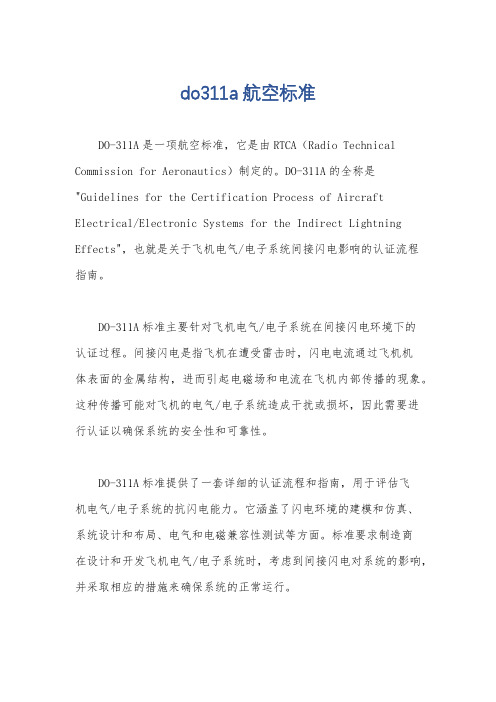
do311a航空标准DO-311A是一项航空标准,它是由RTCA(Radio Technical Commission for Aeronautics)制定的。
DO-311A的全称是"Guidelines for the Certification Process of Aircraft Electrical/Electronic Systems for the Indirect Lightning Effects",也就是关于飞机电气/电子系统间接闪电影响的认证流程指南。
DO-311A标准主要针对飞机电气/电子系统在间接闪电环境下的认证过程。
间接闪电是指飞机在遭受雷击时,闪电电流通过飞机机体表面的金属结构,进而引起电磁场和电流在飞机内部传播的现象。
这种传播可能对飞机的电气/电子系统造成干扰或损坏,因此需要进行认证以确保系统的安全性和可靠性。
DO-311A标准提供了一套详细的认证流程和指南,用于评估飞机电气/电子系统的抗闪电能力。
它涵盖了闪电环境的建模和仿真、系统设计和布局、电气和电磁兼容性测试等方面。
标准要求制造商在设计和开发飞机电气/电子系统时,考虑到间接闪电对系统的影响,并采取相应的措施来确保系统的正常运行。
DO-311A标准的应用范围包括商用航空、通用航空和军用航空等领域。
它对飞机制造商、设备供应商、认证机构和监管机构都具有指导和规范作用。
通过遵循DO-311A标准,可以提高飞机电气/电子系统的可靠性和安全性,减少由于间接闪电引起的故障和事故风险。
总结起来,DO-311A是一项关于飞机电气/电子系统间接闪电影响认证流程的航空标准,它提供了一套详细的指南和流程,用于评估和确保飞机电气/电子系统在闪电环境下的安全性和可靠性。
2011年最新RTCA国外标准原文目录
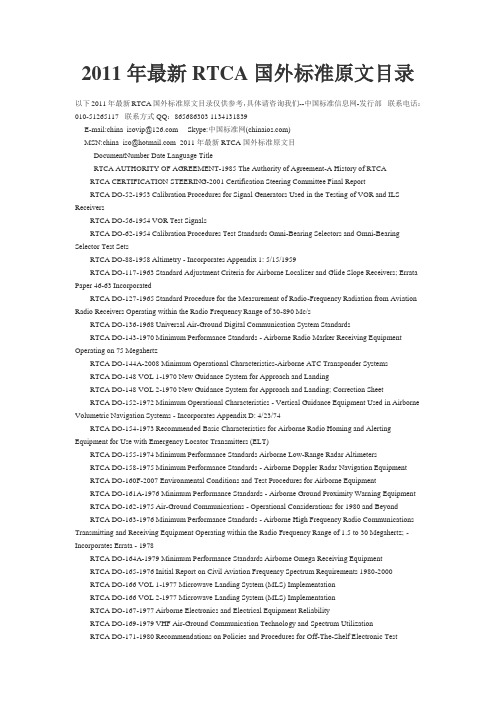
2011年最新RTCA国外标准原文目录以下2011年最新RTCA国外标准原文目录仅供参考,具体请咨询我们--中国标准信息网-发行部联系电话:010-******** 联系方式QQ:865686303 1134131839E-mail:china_isovip@ Skype:中国标准网()MSN:china_iso@ 2011年最新RTCA国外标准原文目DocumentNumber Date Language TitleRTCA AUTHORITY OF AGREEMENT-1985 The Authority of Agreement-A History of RTCARTCA CERTIFICATION STEERING-2001 Certification Steering Committee Final ReportRTCA DO-52-1953 Calibration Procedures for Signal Generators Used in the Testing of VOR and ILS ReceiversRTCA DO-56-1954 VOR Test SignalsRTCA DO-62-1954 Calibration Procedures Test Standards Omni-Bearing Selectors and Omni-Bearing Selector Test SetsRTCA DO-88-1958 Altimetry - Incorporates Appendix 1: 5/15/1959RTCA DO-117-1963 Standard Adjustment Criteria for Airborne Localizer and Glide Slope Receivers; Errata Paper 46-63 IncorporatedRTCA DO-127-1965 Standard Procedure for the Measurement of Radio-Frequency Radiation from Aviation Radio Receivers Operating within the Radio Frequency Range of 30-890 Mc/sRTCA DO-136-1968 Universal Air-Ground Digital Communication System StandardsRTCA DO-143-1970 Minimum Performance Standards - Airborne Radio Marker Receiving Equipment Operating on 75 MegahertzRTCA DO-144A-2008 Minimum Operational Characteristics-Airborne ATC Transponder SystemsRTCA DO-148 VOL 1-1970 New Guidance System for Approach and LandingRTCA DO-148 VOL 2-1970 New Guidance System for Approach and Landing; Correction SheetRTCA DO-152-1972 Minimum Operational Characteristics - Vertical Guidance Equipment Used in Airborne Volumetric Navigation Systems - Incorporates Appendix D: 4/23/74RTCA DO-154-1973 Recommended Basic Characteristics for Airborne Radio Homing and Alerting Equipment for Use with Emergency Locator Transmitters (ELT)RTCA DO-155-1974 Minimum Performance Standards Airborne Low-Range Radar AltimetersRTCA DO-158-1975 Minimum Performance Standards - Airborne Doppler Radar Navigation Equipment RTCA DO-160F-2007 Environmental Conditions and Test Procedures for Airborne EquipmentRTCA DO-161A-1976 Minimum Performance Standards - Airborne Ground Proximity Warning Equipment RTCA DO-162-1975 Air-Ground Communications - Operational Considerations for 1980 and BeyondRTCA DO-163-1976 Minimum Performance Standards - Airborne High Frequency Radio Communications Transmitting and Receiving Equipment Operating within the Radio Frequency Range of 1.5 to 30 Megahertz; - Incorporates Errata - 1978RTCA DO-164A-1979 Minimum Performance Standards Airborne Omega Receiving EquipmentRTCA DO-165-1976 Initial Report on Civil Aviation Frequency Spectrum Requirements 1980-2000RTCA DO-166 VOL 1-1977 Microwave Landing System (MLS) ImplementationRTCA DO-166 VOL 2-1977 Microwave Landing System (MLS) ImplementationRTCA DO-167-1977 Airborne Electronics and Electrical Equipment ReliabilityRTCA DO-169-1979 VHF Air-Ground Communication Technology and Spectrum UtilizationRTCA DO-171-1980 Recommendations on Policies and Procedures for Off-The-Shelf Electronic TestEquipment Acquisition and SupportRTCA DO-172-1980 Minimum Operational Performance Standards for Airborne Radar Approach and Beacon Systems for Helicopters - Change No.1RTCA DO-173-1980 Minimum Operational Performance Standards for Airborne Weather and Ground Mapping Pulsed Radars - Incorporates Corrigendum: 1981, Errata: 1982, and Change No. 1: 1985 RTCA DO-174-1981 Minimum Operational Performance Standards for Optional Equipment Which Displays Non-Radar Derived Data on Weather and Ground Mapping Radar IndicatorsRTCA DO-175-1981 Minimum Operational Performance Standards for Ground Based Automated Weather Observation EquipmentRTCA DO-176-1981 FM Broadcast Interference Related to Airborne ILS, VOR and VHF Communications - Errata - 1984RTCA DO-177-1981 Minimum Operational Performance Standards for Microwave Landing System (MLS) Airborne Receiving Equipment - Incorporates Change No.1: 1982 and Change No.2: 09/19/1986 RTCA DO-178B-1992 Software Considerations in Airborne Systems and Equipment Certification - Errata - 1999RTCA DO-179-1982 Minimum Operational Performance Standards for Automatic Direction Finding (ADF) EquipmentRTCA DO-180A-1990 Minimum Operational Performance Standards for Airborne Area Navigation Equipment Using a Single Collocated VOR/DME Sensor InputRTCA DO-181D-2008 Minimum Operational Performance Standards for Air Traffic Control Radar Beacon System/Mode Select (ATCRBS/Mode S) Airborne Equipment - To Purchase: Contact IHS at 1-800-854-7179 USA/Canada or 303-397-7956 WorldwideRTCA DO-182-1982 Emergency Locator Transmitter (ELT) Equipment Installation and PerformanceRTCA DO-183-1983 Minimum Operational Performance Standards for Emergency Locator Transmitters: Automatic Fixed - ELT (AF); Automatic Portable - ELT (AP): Automatic Depolyable - ELT (AD); Survival - ELT (S); Operating on 121.5 and 243.0 MegahertzRTCA DO-184 1983 TCAS I Functional GuidelinesRTCA DO-185B 2008 Minimum Operational Performance Standards for Traffic Alert and Collision Avoidance System II (TCAS II) - To Purchase: Contact IHS at 1-800-854-7179 USA/Canada or 303-397-7956 WorldwideRTCA DO-186B 2005 Minimum Operational Performance Standards for Airborne Radio Communications EquipmentRTCA DO-187 1984 Minimum Operational Performance Standards for Airborne Area Navigation Equipment Using Multi-Sensor InputsRTCA DO-188 1984 Emergency Locator Transmitter (ELT) Batteries Guidance and Recommendations RTCA DO-189 1985 Minimum Operational Performance Standards for Airborne Distance Measuring Equipment (DME) Operation within the Radio Frequency Range of 960-1215 MegahertzRTCA DO-190 1986 Minimum Operational Performance Standards for Airborne Area Navigation Equipment Using Omega/VLF InputsRTCA DO-191 1986 Minimum Operational Performance Standards for Airborne Thunderstorm Detection EquipmentRTCA DO-192 1986 Minimum Operational Performance Standards for Airborne ILS Glide Slope Receiving Equipment Operating within the Radio Frequency Range of 328.6-335.4 MHz - Superseded DO-132A RTCA DO-193 1986 User Requirements for Future Communications, Navigation, and Surveillance Systems,Including Space Technology ApplicationsRTCA DO-194 1986 Minimum Operational Performance Standards for Airborne Area Navigation Equipment Using Loran-C InputsRTCA DO-195 1986 Minimum Operational Performance Standards for Airborne ILS Localizer Receiving Equipment Operating within the Radio Frequency Range of 108-112 MHzRTCA DO-196 1986 Minimum Operational Performance Standards for Airborne VOR Receiving Equipment Operating within the Radio Frequency Range of 108-117.95 MHzRTCA DO-197A 1994 Minimum Operational Performance Standards for an Active Traffic Alert and Collision Avoidance System I (Active TCAS I) - Errata 11/22/1994; Change No.1 - 1997RTCA DO-199 VOL I 1988 Potential Interference to Aircraft Electronic Equipment from Devices Carried AboardRTCA DO-199 VOL II 1988 Potential Interference to Aircraft Electronic Equipment from Devices Carried AboardRTCA DO-200A 1998 Standards for Processing Aeronautical DataRTCA DO-201A 2000 User Recommendations for Aeronautical Information ServicesRTCA DO-202 1988 Report of Special Committee 159 on Minimum Aviation System Performance Standards (MASPS) for Global Positioning System (GPS)RTCA DO-204A 2007 Minimum Operational Performance Standards for 406 MHz Emergency Locator Transmitters (ELT)RTCA DO-206 1990 Minimum Aviation System Performance Standards for Radiodetermination Satellite Service (RDSS)RTCA DO-207 1991 Minimum Operational Performance Standards for Devices That Prevent Blocked Channels Used in Two-Way Radio Communications Due to Unintentional TransmissionsRTCA DO-208 1991 Minimum Operational Performance Standards for Airborne Supplemental Navigation Equipment Using Global Positioning System (GPS) - Includes Change No.1: 09/21/1993 and Change No.1 Errata: 03/16/1995RTCA DO-209 1992 Minimum Operational Performance Standards for Devices That Prevent Blocked Channels Used in Two-Way Radio Communications Due to Simultaneous Transmissions - Errata - 1992 RTCA DO-210D CHG 3 2006 Minimum Operational Performance Standards (MOPS) for Geosynchronous Orbit Aeronautical Mobile Satellite Services (AMSS) AvionicsRTCA DO-210D CHG 2 2001 Minimum Operational Performance Standards (MOPS) for Geosynchronous Orbit Aeronautical Mobile Satellite Services (AMSS) AvionicsRTCA DO-210D CHG 1 2000 Minimum Operational Performance Standards (MOPS) for Geosynchronous Orbit Aeronautical Mobile Satellite Services (AMSS) AvionicsRTCA DO-210D 2000 Minimum Operational Performance Standards for Geosynchronousorbit Aeronautical Mobile Satellite Services (AMSS) AvionicsRTCA DO-211 1992 User Requirements for Future Airport and Terminal Area Communications, Navigation and SurveillanceRTCA DO-212 1992 Minimum Operational Performance Standards for Airborne Automatic Dependent Surveillance (ADS) EquipmentRTCA DO-213 1993 Minimum Operational Performance Standards for Nose-Mounted Radomes - Change No. 1 - 1995RTCA DO-214 1993 Audio Systems Characteristics and Minimum Operational Performance Standards for Aircraft Audio Systems and EquipmentRTCA DO-215A CHG 1 1998 Guidance on Aeronautical Mobile Satellite Service (AMSS) End-To-End System PerformanceRTCA DO-215A 1995 Guidance on Aeronautical Mobile Satellite Service (AMSS) End-To-End System PerformanceRTCA DO-216 1993 General Specifications for Ground Based Electronic EquipmentRTCA DO-217 1993 Minimum Aviation System Performance Standards DGNSS Instrument Approach System; Special Category I (SCAT-I) - Includes Change No.1: 08/13/1994 and Change No.2: 11/15/1996 RTCA DO-219 1993 Minimum Operational Performance Standards for ATC Two-Way Data Link CommunicationsRTCA DO-220 1993 Minimum Operational Performance Standards for Airborne Weather Radar with Forward-Looking Windshear Compatibility - Change No. 1 - 1995RTCA DO-221 1994 Guidance and Recommended Requirements for Airport Surface Movement Sensors RTCA DO-222 1994 Guidelines on AMS(R)S Near-Term Voice Implementation and Utilization - Errata - 1994RTCA DO-223 1994 Minimum Operational Performance Standards for Aircraft Context Management (CM) EquipmentRTCA DO-224B 2005 Signal-In-Space Minimum Aviation System Performance Standards (MASPS) for Advanced VHF Digital Data Communications Including Compatibility with Digital Voice Techniques RTCA DO-225 1994 VHF Air-Ground Communications System Improvements Alternatives Study and Selection of Proposals for Future ActionRTCA DO-226 1995 Guidance Material for Evolving Airborne Precision Area Navigation Equipment with Emphasis on MLSRTCA DO-227 1995 Minimum Operational Performance Standards for Lithium BatteriesRTCA DO-228 CHG 1 2000 Minimum Operational Performance Standards for Global Navigation Satellite Systems (GNSS) Airborne Antenna EquipmentRTCA DO-228 1995 Minimum Operational Performance Standards for Global Navigation Satellite System (GNSS) Airborne Antenna EquipmentRTCA DO-229D 2006 Minimum Operational Performance Standards for Global Positioning System/Wide Area Augmentation System Airborne EquipmentRTCA DO-230B 2008 Integrated Security System Standard for Airport Access ControlRTCA DO-231 1996 Design Guidelines and Recommended Standards for the Implementation and Use of AMS(R)S Voice Services in a Data Link EnvironmentRTCA DO-232 1996 Operations Concepts for Data Link Applications of Flight Information ServicesRTCA DO-233 1996 Portable Electronic Devices Carried on Board Aircraft - Errata: 8/18/1999RTCA DO-234 1996 Minimum Performance and Installation Standards for Runway Guard Lights (RGLs) RTCA DO-235B 2008 Assessment of Radio Frequency Interference Relevant to the GNSS L1 Frequency BandRTCA DO-236B 2003 Minimum Aviation System Performance Standards: Required Navigation Performance for Area NavigationRTCA DO-237 1997 Aeronautical Spectrum Planning for 1997-2010RTCA DO-238 1997 Human Engineering Guidance for Data Link SystemsRTCA DO-239 1997 Minimum Operational Performance Standards for Traffic Information Service (TIS) Data Link Communications - ERRATA 10/17/1997RTCA DO-240 1997 Minimum Operational Performance Standards (MOPS) for AeronauticalTelecommunication Network (ATN) AvionicsRTCA DO-241 1997 Operational Concepts and Data Elements Required to Improve Air Traffic Management (ATM) - Aeronautical Operational Control (AOC) Ground-Ground Information Exchange to Facilitate Collaborative Decision MakingRTCA DO-242A CHG 1 2006 Minimum Aviation System Performance Standards for Automatic Dependent Surveillance Broadcast (ADS B)RTCA DO-242A 2002 Minimum Aviation System Performance Standards for Automatic Dependent Surveillance Broadcast (ADS-B)RTCA DO-243 1998 Guidance for Initial Implementation of Cockpit Display of Traffic InformationRTCA DO-244 1998 GOVERNMENT/INDUSTRY GUIDELINES AND CONCEPT FOR NATIONAL AIRSPACE ANALYSIS AND REDESIGNRTCA DO-245A 2004 Minimum Aviation System Performance Standards for Local Area Augmentation System (LAAS)RTCA DO-246D 2008 GNSS Based Precision Approach Local Area Augmentation System (LAAS)鈥?Signal-in-Space Interface Control Document (ICD)RTCA DO-247 1999 ROLE OF THE GLOBAL NAVIGATION SATELLITE SYSTEM (GNSS) IN SUPPORTING AIRPORT SURFACE OPERATIONSRTCA DO-248B 2001 FINAL ANNUAL REPORT FOR CLARIFICATION OF DO-178B "SOFTWARE CONSIDERATIONS IN AIRBORNE SYSTEMS AND EQUIPMENT CERTIFICATION"RTCA DO-249 1999 DEVELOPMENT AND IMPLEMENTATION PLANNING GUIDE FOR AUTOMATIC DEPENDENT SURVEILLANCE BROADCAST (ADS-B) APPLICATIONS RTCA DO-250 2000 GUIDING PRINCIPLES FOR AIR TRAFFIC SERVICES PROVIDED VIA DATA COMMUNICATIONS UTILIZING THE ATN, BUILDS I AND IARTCA DO-251 2000 U.S. NATIONAL AIRSPACE SYSTEM (NAS) PLAN FOR AIR TRAFFIC SERVICES DATA LINK (PHASE 1, EN ROUTE CONUS IMPLEMENTATION)RTCA DO-252 2000 MINIMUM INTEROPERABILITY STANDARDS (MIS) FOR AUTOMATED METEOROLOGICAL TRANSMISSION (AUTOMET)RTCA DO-253C 2008 Minimum Operational Performance Standards for GPS Local Area Augmentation System Airborne Equipment - To Purchase: Contact IHS at 1-800-854-7179 USA/Canada or 303-397-7956 WorldwideRTCA DO-254 2000 DESIGN ASSURANCE GUIDANCE FOR AIRBORNE ELECTRONIC HARDWARE RTCA DO-255 2000 Requirements Specification for Avionics Computer Resource (ACR)RTCA DO-256 2000 Minimum Human Factors Standards for Air Traffic Services Provided Via Data Communications Utilizing the ATN, Builds I IARTCA DO-257A 2003 Minimum Operational Performance Standards for the Depiction of Navigation Information on Electronic MapsRTCA DO-258A 2005 Interoperability Requirements for ATS Applications Using ARINC 622 Data CommunicationsRTCA DO-259 2000 Applications Descriptions for Initial Cockpit Display of Traffic Information (CDTI) ApplicationsRTCA DO-260B 2009 Minimum Operational Performance Standards for 1090 MHz Extended Squatter Automatic Dependent Surveillance 鈥?Broadcast (ADS-B) and Traffic Information Services 鈥?Broadcast (TIS-B)RTCA DO-261 2000 NAVSTAR GPS L5 Signal SpecificationRTCA DO-262A 2008 Minimum Operational Performance Standards for Avionics Supporting Next Generation Satellite Systems (NGSS)RTCA DO-263 2000 Application of Airborne Conflict Management: Detection, Prevention, & Resolution RTCA DO-264 2000 Guidelines for Approval of the Prevision and Use of Air Traffic Services Supported by Data CommunicationsRTCA DO-265 2000 Minimum Operational Performance Standards for Aeronautical Mobile High Frequency Data Link (HFDL)RTCA DO-266 2000 Goverment and Industry Guidelines and Concepts for MAS Analysis and Redesign RTCA DO-267A 2004 Minimum Aviation System Performance Standards (MASPS) for Flight Information Services-Broadcast (FIS-B) Data LinkRTCA DO-268 2001 Concept of Operations, Night Vision Imaging System for Civil OperatorsRTCA DO-269 2001 Concepts for Services Integrating Flight Operations and Air Traffic Management Using Addressed Data LinkRTCA DO-270 CHG 1 2009 Minimum Aviation System Performance Standards (MASPS) for the Aeronautical Mobile-Satellite (R) Service (AMS(R)S) as Used in Aeronautical Data LinksRTCA DO-270 2001 Minimun Aviation System Performance Standards (MASPS) for the Aeronautical Mobile-Satellite (R) Service (AMS(R)S) as Used in Aeronautical Data LinksRTCA DO-271C 2005 Minimum Operational Performance Standards for Aircraft VDL Mode 3 Transceiver Operating in the Frequency Range 117.975-137.000 MHzRTCA DO-272B 2009 User Requirements for Aerodrome Mapping InformationRTCA DO-273 2001 Response to the Report of the RTCA Chairman麓s Committee on NEXCOMRTCA DO-274 2001 Next Generation Air/Ground Communications (NEXCOM) Principles of Operation RTCA DO-275 2001 Minimum Operational Performance Standards for Integrated Night Vision Imaging System EquipmentRTCA DO-276A 2005 User Requirements for Terrain and Obstacle DataRTCA DO-277 2002 Minimum Aviation System Performance Standards (MASPS) for the High Frequency Data Link OPerating in the Aeronautical Mobile (Route) Service (AM(R)S)RTCA DO-278 2002 Guidelines for Communications, Navigation, Surveillance, and Air Traffic Management (CNS/ATM) Systems Software Integrity AssuranceRTCA DO-279 2002 NEXT GENERATION AIR/GROUND COMMUNICATIONS (NECXCOM) PRINCIPLES OF OPERATION VDL MODE 3RTCA DO-280B 2007 Interoperability Requirements Standard for ATN Baseline 1 (INTEROP ATN B1) RTCA DO-281A 2005 Minimum Operational Performance Standards for Aircraft VDL Mode 2 Physical, Link and Network LayerRTCA DO-282B 2009 Minimum Operational Performance Standards for Universal Access Transceiver (UAT) Automatic Dependent Surveillance 鈥?BroadcastRTCA DO-283A 2003.10.28 Minimum Operational Performance Standards for Required Navigation Performance for Area NavigationRTCA DO-284 2003 Next Generation Air/Ground Communication System (NEXCOM) Safety and Performance Requirements (SPR) - Includes: Change 1 - 06/25/2003RTCA DO-285 2003 Next Generation Air/Ground Communications (NEXCOM) VDL Mode 3 InteroperabilityRTCA DO-286B 2007 Minimum Aviation System Performance Standards (MASPS) for Traffic Information Service 鈥?Broadcast (TIS-B)RTCA DO-287 2003 Plans and Principles for the Implementation of Aeronautical Data Link System (ADLS) Edition 1. Aeronautical Telecommunication Network (ATN) Baseline 1 Implementation and ADSL Build IIA & IIBRTCA DO-288 2003 Next Generation Air/Ground Communication System (NEXCOM) Implementation RTCA DO-315 2008 Minimum Aviation System Performance说明:2011年最新RTCA国外标准原文目录可以提供,如需要订购单个标准,请与我们联系。
中国民用航空技术标准规定 独立式北斗机载导航有源双频天线(B1C 和B2a 频段)-英文版

Number:CTSO-2C608Date of approval:March 24,2023Approved by:Yang Zhenmei China Civil Aviation Technical Standard Order This China Civil Aviation Technical Standard Order (CTSO) is issued according to Part 37 of the China Civil Aviation Regulations (CCAR-37). Each CTSO is a criterion which the concerned aeronautical materials, parts or appliances used on civil aircraft must comply with when it is presented for airworthiness certification.Independent BDS Airborne Active Navigation Antennafor the B1C and B2a Frequency Bands1.Purpose.This China Civil Aviation Technical Standard Order (CTSO) is applicable to the manufacturers of the Project Approval for application of CTSO authorization (CTSOA) for independent BDS(BeiDou Navigation Satellite System) airborne active navigation antenna for the B1C and B2a frequency bands. This CTSO specifies the minimum performance standards(MPS) that independent BDS airborne active navigation antenna for the B1C and B2a frequency bands must first meet for approval and identification with the applicable CTSO marking.2.Applicability.This CTSO affects new application submitted after its effective date. Major design changes to article approved under this CTSO will require a new authorization in accordance with section 21.353 of CCAR-21R4.3. RequirementsThe equipment manufactured on or after the effective date of this CTSO and intended to be marked with this CTSO mark shall meet the minimum performance standards specified in Appendix 1 of this CTSO.a. Functionality.This CTSO standard is applicable to the independent BDS airborne active navigation antenna for the B1C and B2a frequency bands used to receive signals from the BDS and provides signals for the independent BDS airborne navigation equipment used in the en-route phases of the aircraft certified according to CCAR-23, CCAR-25, CCAR-27, CCAR-29 and CCAR-31.b. Failure Condition Classifications.(1) Failure of the function defined in Section 3.a is a minor failure condition if it causes erroneous information.(2) Loss of the function defined in Section 3.a is a failure condition without safety impact.(3) Design the system to at least these failure condition classifications.c. Functional Qualification.The test conditions specified in Appendix 1 of this CTSO shall prove that the performance of the equipment meets the requirements.d. Environmental Qualification.According to the test conditions in Appendix 1 of this CTSO, the standard environmental conditions and test procedures applicable to the equipment shall be adopted to prove that the performance of the equipment meets the requirements. In addition to RTCA/DO-160G, the applicant may also adopt other applicable standard environmental conditions and test procedures.Note 1:Some performance requirements in Appendix 1 are not required to be tested under all conditions contained in RTCA/DO-160G. If it can be shown that these specific performance parameters are not easily affected by environmental conditions according to calculation analysis, comparative analysis of similar designs, etc. and that the performance levels specified in Appendix 1 are not significantly reduced by exposure to such special environmental conditions, then this Class tests can be ignored.e.Software Qualification.If the article includes software, develop the software according to RTCA/DO-178C, Software Considerations in Airborne Systems and Equipment Certification, dated December 13, 2011, including referenced supplements as applicable, to at least the software level consistent with the failure condition classification defined in paragraph 3.b of this CTSO. The applicant may also develop the software according to RTCA/DO-178B, dated December 1, 1992.f.Electronic Hardware Qualification.If the article includes complex custom airborne electronic hardware, develop the component according to RTCA/DO-254, dated April 19, 2000, Design Assurance Guidance for Airborne Electronic Hardware, to at least the design assurance level consistent with the failure condition classification defined in paragraph 3.b of this CTSO. For custom airborne electronic hardware determined to be simple, RTCA/DO-254, paragraph1.6 applies.g. Deviations.For using alternative or equivalent means of compliance to the criteria in this CTSO, the applicant must show that the equipment maintains an equivalent level of safety. Apply for a deviation under the provision of 21.368(a) in CCAR-21R4.4. Marking.a. Mark at least one major component permanently and legibly with all the information in 21.423(b) of CCAR-21R4. The marking must include the serial number.b. Also, mark the following permanently and legibly, with at least the manufacturer’s name, subassembly part number, and the CTSO number:(1) Each component that is easily removable (without hand tools);(2) Each subassembly of the article that manufacturer determinedmay be interchangeable.c. If the article includes software and/or airborne electronic hardware, then the article part numbering scheme must identify the software and airborne electronic hardware configuration. The part numbering scheme can use separate, unique part numbers for software, hardware, and airborne electronic hardware.d. The applicant may use electronic part marking to identify software or airborne electronic hardware components by embedding the identification within the hardware component itself (using software) rather than marking it on the equipment nameplate. If electronic marking is used, it must be readily accessible without the use of special tools or equipment.5. Application Data Requirements.The applicant must furnish the responsible certification personnel with the related data to support design and production approval. The application data include a statement of conformance as specified in section 21.353(a)(1) in CCAR-21R4 and one copy each of the following technical data:a. A Manual(s) containing the following:(1) Operating instructions and equipment limitations sufficient to describe the equipment’s operational capability.(2) Describe in detail any deviations.(3) Installation procedures and limitations sufficient to ensure that the antenna equipment, when installed according to the installation or operational procedures, still meet this CTSO’s requirements. Limitations must identify any unique aspects of the installation. The limitations must include a note with the following statement:“This article meets the minimum performance and quality control standards required by a CTSO. Installation of this article requires separate approval.”(4) For each unique configuration of software and airborne electronic hardware, reference the following:(i) Software part number including revision and design assurance level;(ii) Airborne electronic hardware part number including revision and design assurance level;(iii) Functional description.(5) A summary of the test conditions used for environmental qualifications for each component of the article. For example, a form as described in RTCA/DO-160G, Environmental Conditions and Test Procedures for Airborne Equipment, Appendix A.(6) Schematic drawings, wiring diagrams, and any other documentation necessary for installation of the antenna equipment.(7) List of replaceable components, by part number, that makes upthe airborne equipment. Include vendor part number cross-references, when applicable.b. Instructions covering periodic maintenance, calibration, and repair, for the continued airworthiness of the antenna equipment. Include recommended inspection intervals and service life, as appropriate.c. If the article includes software: a plan for software aspects of certification (PSAC), software configuration index, and software accomplishment summary.d. If the article includes hardware: a plan for hardware aspects of certification (PHAC), hardware configuration index and hardware completion accomplishment summary.e. A drawing depicting how the article will be marked with the information required by paragraph 4 of this CTSO.f. Identify functionality or performance contained in the article not evaluated under paragraph 4 of this CTSO (that is, non-CTSO functions). Non-CTSO functions are accepted in parallel with the CTSO authorization. For those non-CTSO functions to be accepted, the applicant must declare these functions and include the following information with CTSO application:(1) Description of the non-CTSO function(s), such as performance specifications, failure condition classifications, software, hardware, and environmental qualification levels. Include a statement confirming thatthe non-CTSO function(s) don’t interfere with the article’s compl iance with the requirements of paragraph 3.(2) Installation procedures and limitations sufficient to ensure that the non-CTSO function(s) meets the declared functions and performance specification(s) described in paragraph 5.f.(1).(3)Continued airworthiness requirements for non-CTSO functions described in section 5.f.(1) of this CTSO.(4) Interface requirements and applicable installation test procedures to ensure compliance with the performance data defined in paragraph 5.f.(1).(5) (if applicable) Test plans, analysis and results, as appropriate, to verify that performance of the hosting CTSO article is not affected by the non-CTSO function(s).(6) (if applicable) Test plans, analysis and results, as appropriate, to verify the function and performance of the non-CTSO function(s) as described in paragraph 5.f.(1).g. The quality system description required by section 21.358 of CCAR-21R4, including functional test specifications. The quality system should ensure that it will detect any change to the approved design that could adversely affect compliance with the CTSO MPS, and reject the article accordingly.h. Material and process specifications list.i. List of all drawings and processes (including revision level) that define the article’s design.j. Manufacturer’s CTSO qualification report showing results of testing accomplished according to paragraph 3.c of this CTSO.6. Manufacturer Data Requirements.Besides the data given directly to the authorities, have the following technical data available for review by the authorities:a. Functional qualification specifications for qualifying each production article to ensure compliance with this CTSO.b. Equipment calibration procedures.c. Schematic drawings.d. Wiring diagrams.e. Material and process specifications.f. The results of the environmental qualification tests conducted according to paragraph 3.d of this CTSO.g. If the article includes software, the appropriate documentation defined in the version of RTCA/DO-178 specified by paragraph 3.e of this CTSO, including all data supporting the applicable objectives in Annex A, Process Objectives and Outputs by Software Level.h. If the article includes complex custom airborne electronic hardware, the appropriate hardware life cycle data in combination with design assurance level, as defined in RTCA/DO-254, Appendix A, TableA-l. For simple custom airborne electronic hardware, the following data: test cases or procedures, test results, test coverage analysis, tool assessment and qualification data, and configuration management records, including problem reports.i. If the article contains non-CTSO function(s), the applicant must also make available items 6.a through 6.h as they pertain to the non-CTSO function(s).7. Furnished Data Requirements.a. If furnishing one or more articles manufactured under this CTSO to one entity (such as an operator or repair station), provide one copy or technical data and information specified in paragraphs 5.a and 5.b of this CTSO. Add any data needed for the proper installation, certification, use, or for continued compliance with the CTSO, of the antenna equipment.b. If the article contains declared non-CTSO function(s), include one copy of the data in paragraphs 5.f.(1) through 5.f.(4).8. Availability of Referenced Documents.Order RTCA documents from:Radio Technical Commission for Aeronautics, Inc.1150 18th Street NW, Suite 910, Washington D.C. 20036Appendix 1 Minimum Performance Standards for Independent BDS Airborne Active Navigation Antenna for the B1C and B2a Frequency BandsIndependent BDS airborne active navigation antenna for the B1C andB2a frequency bands shall meet the requirements of Chapter 2 of RTCA/DO-373 “MOPS for GNSS Airborne Active Antenna Equipment for the L1/E1 and L5/E5a Frequency Bands”and the following modifications1.Modify2.1.2 to “The antenna shall perform its intended function(s), asdefined by the manufacturer, and its proper use shall not create a hazard to other airspace users”.2.Modify 2.1.3 to “All equipment shall comply with the RadioRegulations of the People's Republic of China”.3.Modify the n ote in 2.1.4 to “Compliance can be demonstrated throughCCAR-25-R4 Appendix F”.4.Modify “L5 GPS”in the first column of the table in 2.2.1 to “B2aBDS”, modify “L1 GPS" in the first column of the table in 2.2.1 to “B1C BDS”, and delete E5a Galileo and E1 Galileo frequencies.Modify “L1/E1” to “B1C” and “L5/E5a” to “B2a” in the full text.5.Delete the note under the table in 2.2.1.6.Modify “1dB Input Compression Point” of 1149.45MHz to “-2dbm”,and modify “1dB Input Compression Point” of 1200.45MHz to“-2dbm”while other frequency points remain unchanged in 2.2.6.3 Boresight Transducer Gain Compression Point.7.Modify “Relative Frequency Response” of 1149.45MHz to “-20dB”,and modify “Relative Frequency Response” of 1200.45MHz to “-20dB” while other frequency points remain unchanged in 2.2.8 Boresight Gain Relative Frequency Response.8.Delete the Group Delay Versus Aspect Angle requirements in 2.2.11.2.9.Delete “2.2.11.2” from “Insert the delay values in the appropriate limitformula in Section 2.2.11 and verify that the requirements of Sub-sections 2.2.11.1 and 2.2.11.2 are met.” in 2.4.2.2.6.10.I n Table 2-7 of 2.4.2.6.2, modify the “RF Peak Field”value of1149.45MHz to “6.65”, modify the “RF Peak Field”value of 1200.45MHz to “6.9”.11.D elete item 2 of note in 2.4.2.4.(The English version is for reference only. In case of any discrepancy or ambiguity of meaning between this English translation and the Chinese version, the latter shall prevail.)。
do160 雷击测试标准
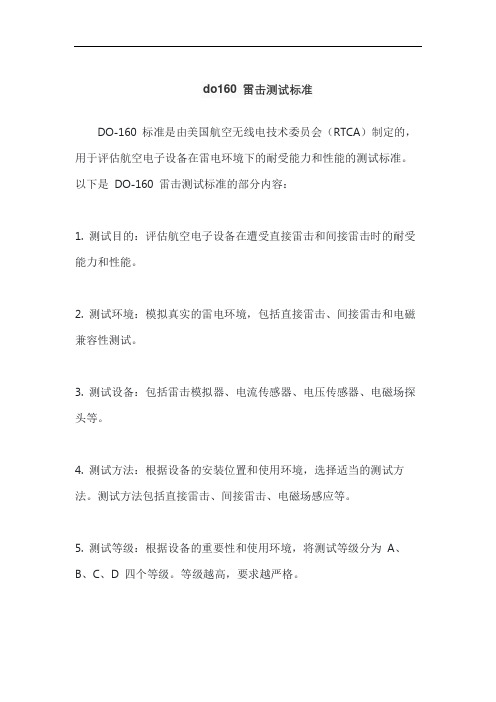
do160 雷击测试标准
DO-160 标准是由美国航空无线电技术委员会(RTCA)制定的,用于评估航空电子设备在雷电环境下的耐受能力和性能的测试标准。
以下是DO-160 雷击测试标准的部分内容:
1. 测试目的:评估航空电子设备在遭受直接雷击和间接雷击时的耐受能力和性能。
2. 测试环境:模拟真实的雷电环境,包括直接雷击、间接雷击和电磁兼容性测试。
3. 测试设备:包括雷击模拟器、电流传感器、电压传感器、电磁场探头等。
4. 测试方法:根据设备的安装位置和使用环境,选择适当的测试方法。
测试方法包括直接雷击、间接雷击、电磁场感应等。
5. 测试等级:根据设备的重要性和使用环境,将测试等级分为A、
B、C、D 四个等级。
等级越高,要求越严格。
6. 测试结果:根据测试结果,评估设备的耐受能力和性能。
如果设备在测试中出现故障或性能下降,需要进行修复或改进。
DO-160 雷击测试标准是航空电子设备必须遵守的标准之一,它可以确保设备在雷电环境下的安全性和可靠性。
do160g 第16章 电源输入 试验项目

do160g 第16章电源输入试验项目
DO-160G是由航空电子协会(RTCA)发布的航空电子设备环
境条件标准。
该标准规定了飞机上电子设备所需满足的环境条件和试验要求。
第16章《电源输入》是DO-160G标准中的一章,主要涵盖了飞机电子设备所需满足的电源输入的试验项目。
试验项目包括但不限于:
1. 电源频率范围测试:测试设备在指定的频率范围内是否正常工作。
2. 电源电压范围测试:测试设备在指定的电压范围内是否正常工作。
3. 输入功率测试:测试设备在正常工作状态下的输入功率是否符合要求。
4. 电源中断和恢复测试:测试设备在电源中断时的恢复能力。
5. 电源波动测试:测试设备在电源波动时的响应和适应能力。
6. 电源逆变测试:测试设备在电源逆变情况下的响应能力。
以上只是DO-160G标准第16章电源输入的部分试验项目,实际试验项目可能会根据具体的电子设备和应用进行调整和补充。
同时,具体的试验方法和要求也需要参考DO-160G标准的具体内容以确保正确执行试验。
(完整版)飞机雷电防护试验的有关标准

(完整版)飞机雷电防护试验的有关标准1.FAR—25和CCAR—25FAR-25《美国联邦航空条例第25部:运输类飞机适航条例》是由美国FAA(联邦航空管理局)颁布的,其中“25.581 闪电防护”、“25。
954 燃油系统的闪电防护"、“25.1316 系统闪电防护”与雷电防护有关,分别对结构部分、燃油系统及机载电子设备的雷电防护能力作了要求,但没有规定防护能力的验证方法。
CCAR—25是由中国民航总局颁布的运输类飞机适航条例,与FAR-25内容基本相同.适航条例对飞机的雷电防护能力提出了要求,飞机获取适航证前,需验证这些能力,当不能满足任一条款对飞机雷电防护的安全性要求时,适航审查当局将拒发适航证,飞机也不得进入航线。
飞机雷电防护适航审查的符合性方法通常有分析计算法、类比法和地面模拟雷电试验法。
分析计算方法主要用于飞机某些能得出准确解得局部结构和部件的计算。
类比法主要是将外形、结构和用途都基本相同的飞机或结构与部件,与已通过适航审查的飞机或结构与部件进行比对,确实相同则可认为满足要求。
地面模拟雷电试验法,主要用于新机型的研制、设计和老机型的改进或改型设计。
由于飞机外形的不规则性及机械结构与电气电子系统的多样性与复杂性,电场与磁场的精确解非常困难,故上述方法中地面模拟雷电试验方法最有效。
目前国内进行地面模拟雷电试验可参考的标准主要有两个RTCA/DO—160和GJB3567A.2.RTCA/DO—160RTCA/DO-160《机载设备环境条件与测试规程》是由RTCA(航空无线电技术委员会)下属的SC135特别委员会起草制定的.DO—160的适用对象包括了所有的航空飞行器,从轻型到重型,从小型到大型,它提供了一整套实验室测试方法以判定被测对象在模拟的环境条件下是否满足规定的性能指标要求。
目前,RTCA/DO—160已更新至F版本(2007年12月发布)。
RTCA/DO—160中的第22节为“雷电感应瞬变敏感度”,第23节为“雷电直接效应”。
架空输电线路机巡光电吊舱技术规范

《架空输电线路机巡光电吊舱技术规范》(试行)二〇一四年三月目次前言 (I)1范围 (1)2规范性引用文件 (1)3术语及定义 (1)4光电吊舱组成与分类 (2)5光电吊舱功能要求 (2)6光电吊舱性能指标要求 (4)7光电吊舱接口要求 (8)8检测试验与验收交付要求 (8)9标示、包装、运输和贮存要求 (10)10使用培训、维护和保养要求 (10)附录 (12)前言为规范架空输电线路有人直升机/无人机巡检用光电吊舱的要求,指导中国南方电网有限责任公司(以下简称“公司”)有人直升机/无人机巡检用光电吊舱的设备选型、试验验收、产品包装运输等方面的工作,依据国家和行业有关标准、规程和规范,特制定本规范。
本规范编写单位:南方电网科学研究院有限责任公司本规范主要起草人:陈晓、张巍、张贵峰、陈鹏、陈艳芳、杨鹤猛、张建民、吴新桥、王英洁、王国利、张拯宁、赵克、袁红卫、李超本规范由公司生产设备管理部提出并负责解释。
执行中的问题和意见,请及时反馈至公司生产设备管理部。
架空输电线路机巡光电吊舱技术规范(试行)1范围本技术规范(以下简称规范)适用于公司架空输电线路有人直升机、中大型无人机巡检用光电吊舱的选配。
本规范对光电吊舱的组成与分类、功能、性能指标、检测试验、验收交付、包装、运输、贮存、培训、维护和保养等做出了具体说明和要求。
2规范性引用文件下列文件中的条款通过本规范的引用而成为本规范的条款。
凡是注日期的引用文件,其随后所有的修改单(不包括勘误的内容)或修订版均不适用于本规范。
凡是不注日期的引用文件,其最新版本适用于本规范。
GB/T658 -2012 电子测量仪器通用规范GB /T 191 包装储运图示标志DL/T288 架空输电线路直升机巡视技术导则DL/T664 带电设备红外诊断应用规范DL/T345 带电设备紫外诊断技术应用导则QJ 2245-1992 电子仪器和设备防静电要求HB 6434-2001 机载电子设备接口设计基本要求HB 5662-1981 飞机设备电磁兼容要求及测试方法HB 6167-1989 民用飞机机载设备环境条件和试验方法GB 4208-2008 外壳防护等级(IP代码)RTCA/DO-160F Environmental Conditions and Test Procedures for Airborne EquipmentRTCA/DO-178C Software Considerations in Airborne Systems and Equipment Certification3术语及定义以下术语和定义适用于本标准。
电压尖峰试验测试标准分析
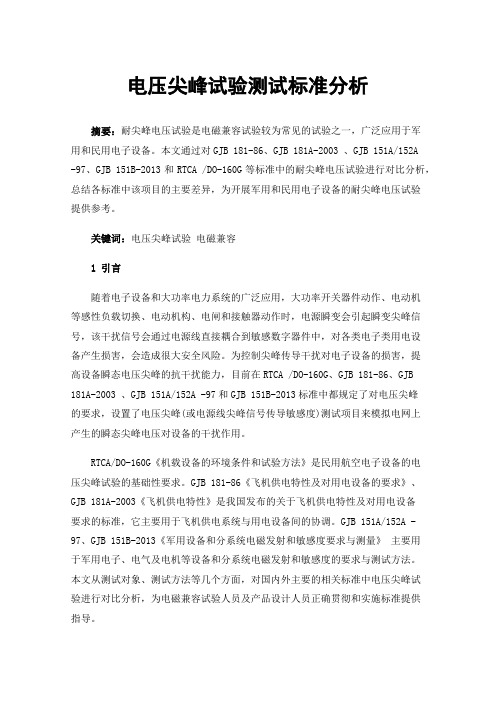
电压尖峰试验测试标准分析摘要:耐尖峰电压试验是电磁兼容试验较为常见的试验之一,广泛应用于军用和民用电子设备。
本文通过对GJB 181-86、GJB 181A-2003 、GJB 151A/152A-97、GJB 151B-2013和RTCA /DO-160G等标准中的耐尖峰电压试验进行对比分析,总结各标准中该项目的主要差异,为开展军用和民用电子设备的耐尖峰电压试验提供参考。
关键词:电压尖峰试验电磁兼容1引言随着电子设备和大功率电力系统的广泛应用,大功率开关器件动作、电动机等感性负载切换、电动机构、电闸和接触器动作时,电源瞬变会引起瞬变尖峰信号,该干扰信号会通过电源线直接耦合到敏感数字器件中,对各类电子类用电设备产生损害,会造成很大安全风险。
为控制尖峰传导干扰对电子设备的损害,提高设备瞬态电压尖峰的抗干扰能力,目前在RTCA /DO-160G、GJB 181-86、GJB 181A-2003 、GJB 151A/152A -97和GJB 151B-2013标准中都规定了对电压尖峰的要求,设置了电压尖峰(或电源线尖峰信号传导敏感度)测试项目来模拟电网上产生的瞬态尖峰电压对设备的干扰作用。
RTCA/DO-160G《机载设备的环境条件和试验方法》是民用航空电子设备的电压尖峰试验的基础性要求。
GJB 181-86《飞机供电特性及对用电设备的要求》、GJB 181A-2003《飞机供电特性》是我国发布的关于飞机供电特性及对用电设备要求的标准,它主要用于飞机供电系统与用电设备间的协调。
GJB 151A/152A -97、GJB 151B-2013《军用设备和分系统电磁发射和敏感度要求与测量》主要用于军用电子、电气及电机等设备和分系统电磁发射和敏感度的要求与测试方法。
本文从测试对象、测试方法等几个方面,对国内外主要的相关标准中电压尖峰试验进行对比分析,为电磁兼容试验人员及产品设计人员正确贯彻和实施标准提供指导。
舰载机载设备腐蚀环境适应性要求的剪裁
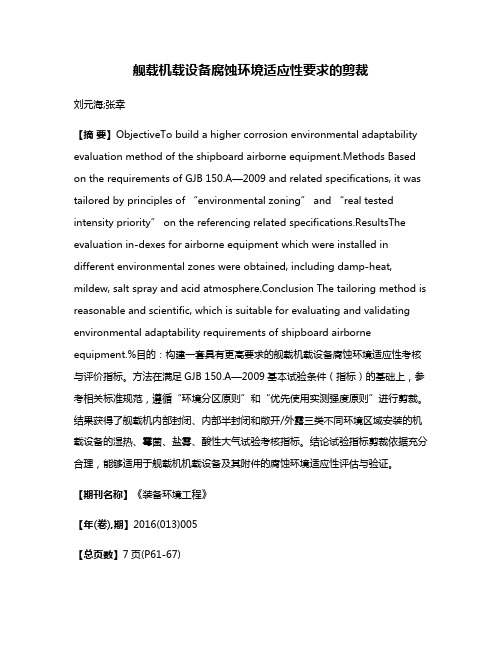
舰载机载设备腐蚀环境适应性要求的剪裁刘元海;张幸【摘要】ObjectiveTo build a higher corrosion environmental adaptability evaluation method of the shipboard airborne equipment.Methods Based on the requirements of GJB 150.A—2009 and related specifications, it was tailored by principles of “environmental zoning” and “real tested intensity priority” on the referencing related specifications.ResultsThe evaluation in-dexes for airborne equipment which were installed in different environmental zones were obtained, including damp-heat, mildew, salt spray and acid atmosphere.Conclusion The tailoring method is reasonable and scientific, which is suitable for evaluating and validating environmental adaptability requirements of shipboard airborne equipment.%目的:构建一套具有更高要求的舰载机载设备腐蚀环境适应性考核与评价指标。
方法在满足GJB 150.A—2009基本试验条件(指标)的基础上,参考相关标准规范,遵循“环境分区原则”和“优先使用实测强度原则”进行剪裁。
机载低空无线电高度表
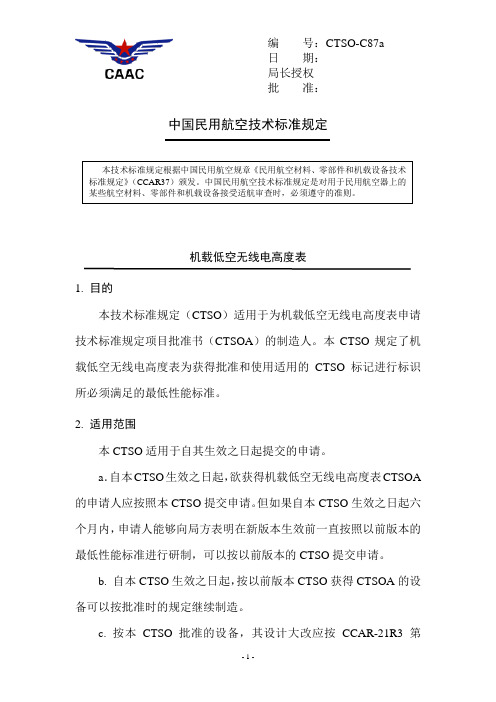
编 号:CTSO-C87a日 期:局长授权批 准:中国民用航空技术标准规定本技术标准规定根据中国民用航空规章《民用航空材料、零部件和机载设备技术标准规定》(CCAR37)颁发。
中国民用航空技术标准规定是对用于民用航空器上的某些航空材料、零部件和机载设备接受适航审查时,必须遵守的准则。
机载低空无线电高度表1. 目的本技术标准规定(CTSO )适用于为机载低空无线电高度表申请技术标准规定项目批准书(CTSOA )的制造人。
本CTSO 规定了机载低空无线电高度表为获得批准和使用适用的CTSO 标记进行标识所必须满足的最低性能标准。
2. 适用范围本CTSO 适用于自其生效之日起提交的申请。
a .自本CTSO 生效之日起,欲获得机载低空无线电高度表CTSOA 的申请人应按照本CTSO 提交申请。
但如果自本CTSO 生效之日起六个月内,申请人能够向局方表明在新版本生效前一直按照以前版本的最低性能标准进行研制,可以按以前版本的CTSO 提交申请。
b. 自本CTSO 生效之日起,按以前版本CTSO 获得CTSOA 的设备可以按批准时的规定继续制造。
c. 按本CTSO 批准的设备,其设计大改应按CCAR-21R3第21.310条要求重新申请CTSOA。
3. 要求在本CTSO生效之日或生效之后制造并欲使用本CTSO标记进行标识的机载低空无线电高度表,应满足EUROCAE 标准ED-30《机载低空无线电高度表最低性能标准》(1980.3)第2版的要求,以及按本CTSO附录1所做的修订。
ED-30中第2章和第3章相关要求与功能类的对应关系如表1所示。
表1低空无线电高度表功能类低空无线电高度表类别描述ED-30中相关要求A 进近和着陆 2.1-2.8,3.1.1,3.2.1(全部),3.3.1B 地形避让(近地警告系统)2.1-2.8,3.1.2,3.2.3(全部),3.3.2 注:同一无线电高度表可满足以上两个功能类。
《航空运营人导航数据库管理规范》 目录
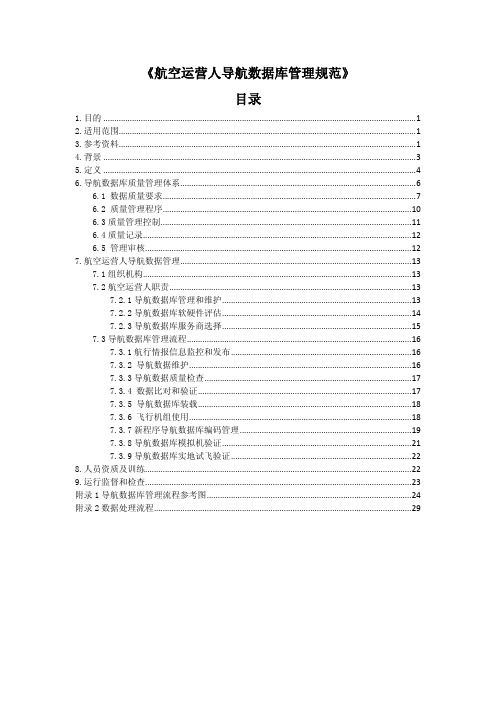
《航空运营人导航数据库管理规范》目录1.目的 (1)2.适用范围 (1)3.参考资料 (1)4.背景 (3)5.定义 (4)6.导航数据库质量管理体系 (6)6.1 数据质量要求 (7)6.2 质量管理程序 (10)6.3质量管理控制 (11)6.4质量记录 (12)6.5 管理审核 (12)7.航空运营人导航数据管理 (13)7.1组织机构 (13)7.2航空运营人职责 (13)7.2.1导航数据库管理和维护 (13)7.2.2导航数据库软硬件评估 (14)7.2.3导航数据库服务商选择 (15)7.3导航数据库管理流程 (16)7.3.1航行情报信息监控和发布 (16)7.3.2 导航数据维护 (16)7.3.3导航数据质量检查 (17)7.3.4 数据比对和验证 (17)7.3.5 导航数据库装载 (18)7.3.6 飞行机组使用 (18)7.3.7新程序导航数据库编码管理 (19)7.3.8导航数据库模拟机验证 (21)7.3.9导航数据库实地试飞验证 (22)8.人员资质及训练 (22)9.运行监督和检查 (23)附录1导航数据库管理流程参考图 (24)附录2数据处理流程 (29)1.目的本管理规范主要为航空运营人导航数据库管理工作提供要求和指南,并为局方相关管理工作提供指导和依据。
本规范并不是导航数据库管理的唯一方法,运营人也可采用中国民航局可接受的其他方法。
2.适用范围本规范适用于CCAR91、121、135部运营人。
规范中所涉及导航数据库,包括航路、终端区和进近等飞行阶段供航空器使用的机载导航数据库。
3.参考资料(1)ICAO附件4《航图》;(2)ICAO附件15《航行情报服务》;(3)ICAO DOC 9613(第3版)《基于性能的导航(PBN)手册》;(4)ICAO DOC 8168(第2卷)《目视和仪表飞行程序设计规范》;(5)ICAO DOC 9906《飞行程序设计质量保证手册》;(6)ICAO DOC 9905《要求授权的所需导航性能(RNP AR)程序设计手册》;(7)ARINC-424(第18版)《导航系统数据库》;(8)RTCA/DO-200A《航空数据处理标准》;(9)RTCA/DO-200《用户可选择的导航数据库的准备、验证和分发》;(10)FAA AC 20-153A《航空数据处理和相关导航数据库的认可》;(11)RTCA/DO-201《航空服务信息的用户建议》;(12)RTCA/DO-201A《航空信息标准》;(13)RTCA/DO-178B《机载系统和设备认证中的软件考虑》;(14)CCAR-175TM-R1《民用航空情报工作规则》;(15)AC-91-08《RNAV5运行批准指南》;(16)AC-91-FS-2008-09《在航路和终端区实施RNAV1和RNAV2的运行指南》;(17)AC-91-FS-2009-12《在海洋和偏远地区空域实施RNP4的运行指南》;(18)AC-91-FS-2010-01R1《在终端区和进近中实施RNP 的运行批准指南》;(19)AC-91FS-05《特殊航空器和机组(SAAAR)实施所需导航性能(RNP)程序的适航和运行批准准则》;(20)AC-97-FS-2011-01《民用航空机场运行最低标准制定与实施准则》。
DO-160标准中电磁兼容测试项目介绍

DO-160标准中电磁兼容测试项⽬介绍RTCA DO-160标准规定了航空机载设备的环境条件和试验程序,其中与EMC相关的测试项⽬有九个章节。
磁场效应RTCA DO-160 Sec 15电源输⼊RTCA DO-160 Sec 16电压尖峰测试RTCA DO-160 Sec 17电源线⾳频传导敏感度RTCA DO-160 Sec 18感应信号敏感度RTCA DO-160 Sec 19射频敏感度(传导和辐射)RTCA DO-160 Sec 20射频能量发射RTCA DO-160 Sec 21感应雷电瞬态敏感度RTCA DO-160 Sec 22静电放电测试RTCA DO-160 Sec 25RTCA DO-160标准中的EMC相关的测试项⽬简单介绍如下:Section 15磁场效应该项测试⽤于测量机载设备所产⽣的DC磁场发射的量值⼤⼩。
测量可以通过罗盘指针的偏转程度测定,或者使⽤⼀个有⾜够精度的⾼斯计测定。
设备的分类取决于产⽣⼀定偏转量值时的距离。
Section 16电源输⼊该项测试⽤于机载设备的电源输⼊端,测量电源总线上伴随产⽣的各种电源畸变和浪涌情况。
设备的分类基于组件的电源功率和定义的不同状态,如供电电源就有115Vac/400Hz,230Vac/400Hz,28Vdc,14Vdc,或者270Vdc多种类型。
Section 17电压尖峰该项测试是向机载设备的电源线注⼊脉宽10µs、上升时间⼩于2µs的瞬态尖峰信号。
适⽤于AC和DC电源的输⼊端,瞬态尖峰信号的幅度有两个对应的等级。
Section 18电源线⾳频传导敏感度该项测试是向机载设备的电源线注⼊正弦波⼲扰信号,适⽤于AC和DC的电源输⼊端。
⼲扰信号的严酷等级根据被测件的电源功率类型⽽不同。
Section 19感应信号敏感度该项测试不仅包括电源频率和瞬态信号引起的磁场感应,⽽且包括电场耦合。
适⽤于机载设备和互连线缆,测试等级取决于抗⼲扰操作的要求程度。
基于适航的民机机载设备环境试验标准需求分析

基于适航的民机机载设备环境试验标准需求分析孔叔钫; 胡湘洪【期刊名称】《《电子产品可靠性与环境试验》》【年(卷),期】2019(037)004【总页数】6页(P83-88)【关键词】适航; 民用飞机机载设备; 环境试验要求; 环境试验标准【作者】孔叔钫; 胡湘洪【作者单位】工业和信息化部电子第五研究所广东广州510610; 广东省电子信息产品可靠性技术重点实验室广东广州510610; 广东省电子信息产品可靠性与环境工程技术研究开发中心广东广州510610; 广东省工业机器人可靠性工程实验室广东广州 510610【正文语种】中文【中图分类】T-6510 引言美国民机行业发展水平处于世界领先地位,美国联邦航空局(FAA: Federal Aviation Administration)制定的适航条例和标准受到了国际化标准组织和世界各飞机制造大国适航当局的认可。
我国在20 世纪80 年代开始制定了与FAR 等效的适航法规和咨询通告CCAR,但目前尚未形成完整的民机环境试验标准体系支撑适航取证。
近年来,随着C919、蛟龙200 等飞机首飞成功,我国民用飞机行业发展取得了较为瞩目的成就。
为了满足我国民机机载设备日趋迫切的适航取证需求,亟需从适航条例出发开展对民机环境试验需求的研究,为后续我国形成完整的民机机载设备环境试验标准体系提供基础,助力我国民机行业的发展。
1 基于FAR 25 部的环境试验需求FAR 25部《运输类飞机适航标准》是运输类飞机型号合格取证的适航标准。
民机机载设备必须按适航标准指定或推荐的咨询通告(AC:Advisory Circular)或行业标准完成相应的取证试验。
虽然适航标准并未直接给出满足适航要求符合性的验证程序,但FAA 针对各项适航条款专门发布了相应的AC,给出了各类设备取证的推荐程序,明确了取证试验的要求。
环境试验是适航取证试验的重要组成部分 [1],通过梳理FAR 25 部,确定了基于适航的民机机载设备环境试验要求,分析了各种适航条款对应的AC,明确了相应的环境试验标准,如表1 所示。
飞机雷电防护试验相关标准

飞机雷电防护试验相关标准国内外与飞机雷电防护试验有关的标准很多,这些标准可分为两类,一类是对飞机的雷电防护能力提出要求的标准,另一类是对飞机的雷电防护方法及试验方法做出规定的标准。
由于我国的适航审查体系基本参照美国,因此主要介绍我国和美国的标准。
1对飞机雷电防护能力提出要求的标准1.1适航条例适航条例对民用飞机的雷电防护能力提出了要求,飞机获取适航证前,需验证这些能力,当不能满足任一条款对飞机雷电防护的安全性要求时,适航审查当局将拒发适航证,飞机也不得进入航线。
中国民航总局颁布适航条例主要有:CCAR-23:正常类、实用类、特技类、通勤类飞机适航条例;CCAR-25:运输类飞机适航条例;CCAR-27:正常类旋翼航空器适航条例。
CCAR-29:运输类旋翼航空器适航条例。
这些适航条例基本参照美国FAA(联邦航空管理局)颁布的FAR(美国联邦航空条例)系列。
CCAR-25对雷电防护要求最为严格,其中“25.581闪电防护”、“25.954燃油系统的闪电防护”、“25.1316系统闪电防护”与雷电防护有关,分别对结构部分、燃油系统及机载电子设备的雷电防护能力作了要求,并要求对防护能力进行验证。
其余适航条例也对雷电防护能力有要求。
1.2MIL-STD-464CMIL-STD-464C《系统电磁环境效应要求》由美国国防部于2010年12月发布,该标准对军用设备(包括飞机)的雷电防护能力提出了要求。
其5.5节规定:“对于雷电的直接效应和间接效应,系统都应满足其工作性能的要求。
当在暴露状态下,经受一个邻近的雷击以后,或在储存条件下经受一个直接雷击后,军械应满足其工作性能要求。
在经受暴露条件下的直接雷击期间及以后,军械应保证安全……符合性应通过系统、分系统、设备和部件(如结构件和天线罩)级试验、分析或其组合来验证。
”1.3GJB1389AGJB1389A《系统电磁兼容性要求》由中国人民解放军总装备部于2005年10月批准发布,对应于MIL-STD-464A(2002年发布)。
- 1、下载文档前请自行甄别文档内容的完整性,平台不提供额外的编辑、内容补充、找答案等附加服务。
- 2、"仅部分预览"的文档,不可在线预览部分如存在完整性等问题,可反馈申请退款(可完整预览的文档不适用该条件!)。
- 3、如文档侵犯您的权益,请联系客服反馈,我们会尽快为您处理(人工客服工作时间:9:00-18:30)。
rtca do-367 标准
RTCA DO-367 标准是美国航空无线电委员会(Radio Technical Commission for Aeronautics,简称 RTCA)发布的一项技术标准,
全称为《地形感知和警告系统(TAWS)的最低运行性能标准(MOPS)》[^1^][1]。
该标准定义了 TAWS 的功能、性能、测试和接口要求,
为 TAWS 的设计、制造、安装和使用提供了技术指导。
TAWS 是一种用于提高飞行安全的航空电子设备,它可以通过接
收和分析来自全球定位系统(GPS)、气压高度表、无线电高度表、
地形数据库等的信息,实时监测飞机与地形的相对位置和高度,预
测可能发生的地形冲突,并向飞行员发出视觉和声音的警告,提示
飞行员采取适当的避难动作[^2^][2]。
RTCA DO-367 标准主要包括以下几个部分:
- 第一部分:概述。
介绍了 TAWS 的背景、目的、范围、适用性、参考文献、术语和缩略语等。
- 第二部分:功能要求。
描述了 TAWS 的基本功能和附加功能,如地形警告、障碍物警告、起飞/着陆配置警告、飞行路径角警告、
过低高度警告等,以及各种功能的工作原理、触发条件、警告级别、警告信息等。
- 第三部分:性能要求。
规定了 TAWS 的性能指标和测试方法,如地形数据库的精度、完整性、时效性、更新频率等,以及 TAWS
的可靠性、可用性、容错性、兼容性等。
- 第四部分:测试要求。
定义了 TAWS 的测试程序和测试案例,包括实验室测试、地面测试、飞行测试等,以及测试的目的、条件、步骤、结果、判据等。
- 第五部分:接口要求。
描述了 TAWS 与其他设备或系统的接
口规范,如数据接口、控制接口、显示接口、音频接口等,以及接
口的类型、格式、内容、速率、协议等。
RTCA DO-367 标准是 FAA 和 ICAO 等航空管理机构认可的TAWS 的技术标准,是 TAWS 的适航认证的重要依据。
遵循 RTCA
DO-367 标准的 TAWS 可以有效地提高飞行安全,防止地形冲突事故
的发生。
